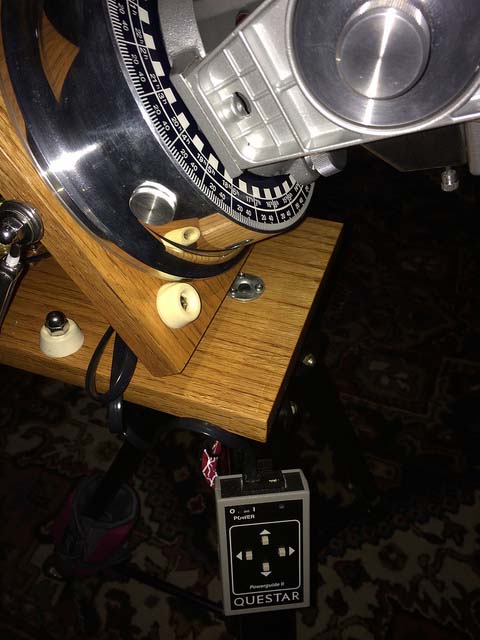- Images
- Blog
- Tools
- Questar
- The Questar telescope
- Questar resource links
- Search for Questar info
- 172mm Focal Reducer
- Afocal adapter for point and shoot camera
- Camera adapter lengths
- Camera adapter threading
- Camera connection
- Camera focusing
- Custom counterweight
- Drift Alignment Joy
- Finder Eyepiece Compatibility
- The Questar Moon 1981
- Questar Powerguide II Battery Life
- Questar Zone, How to Service Videos
- Red Dot finder mount for Questar
- Questar Viewing Table
- Wedge mounts
- White light solar filters comparison
- How to
- Get started in astronomy
- Astro RaspberryPi Camera and kin, the ASIAir and StellarMate
- Blind Smart-phone Equatorial Wedge or GEM Polar Alignment
- Camera phone adapter
- Celestron FirstScope with equatorial tripod mount
- Coat Pocket Astrophotography
- Day-lapse Images of Earthshine on the Crescent Moon
- Dobsonian Carrying Case
- DSO Astrophotography without a Telescope
- DSO imaging without a star tracker
- Estimating image resolution
- Lunar Eclipse Photography
- Moon photography - a dozen ways to shoot the Moon
- Meteor shower photography & planning
- Matching image sensor size to telescope resolution
- Narrow band imaging with color cameras
- Planetary Image Workflow
- Print and Display Astrophotography
- Observing
- Events
- More
- About
- Contact
Adjustable wood mount wedge
An easy to make an adjustable wedge for the Questar
The adjustable Questar legs are fine for table top observing. When a table isn't available or a more stable mounting is needed, a sturdy tripod and wedge mount are a good solution. Sturdy second hand tripods are easy to find and together with a wedge like this one, the total cost can be an order of magnitude less than commercial alternatives. I frequently use this wedge with a vintage Davis and Sanford tripod. At less than 9 pounds, I find it convenient and lightweight, yet solid enough for astrophotography.
A wooden wedge for the Questar is easy to make with simple tools. A non-magnetic wedge makes it easy to do quick polar alignments when Polaris isn't visible. Mine is basically two pieces of standard "8 x 1" oak board: one 7 1/2" x 7 3/8" x 3/4" and the other 10" x 7 3/8" x 3/4". The hardware is all non-magnetic stainless steel, most was not available locally, but was easy to find on Amazon and eBay:
- piano hinge, cut to length with a hack saw
- 2 turnbuckles to adjust the wedge angle
- a 1/4" x 20 tpi thumb screw with enough reach to attach the telescope to the wedge (1 to 1 1/8").
- pivot bearings were made with small hanger bolts (one end wood screw the other machine screw). Nylon standoffs and washers were used to make a snug bearing on the machine screw side, finished off with a cap bolt.
- A 3/8 x 16 tpi T-nut to attach the wedge base to the tripod
- small rubber feet for guides
- a quality compass adjustable for magnetic deviation
- a sensitive bubble level
My design has no azimuth adjustment, because my tripod provides allows adjustment of the direction of the wedge in the horizontal plane. I wasn't able to obtain the small hanger bolts in stainless steel, but by placing the symmetrically around the compass their magnetic effect is nullified.
The piano hinge is placed close to one end of the longer base board to allow clearance for a camera. Mine has enough room for eyepice caps and the T-nut. The exact placement of the T-nut depends on your latitude and equipment. Your telescope with eyepiece and camera should balance at the T-nut location.
The placement of the pivot bearings depends on the latitudes that you observe from and the length of your turn buckles. I added a second pair of pivot bearings for high latitudes.
I was not able to obtain finely threaded stainless steel turnbuckles, but with two of them it is easy to buck the adjustments in opposite directions so that you have a good tight adjustment that will hold its position.
I made my own thumb screw. I used a 1/4 "x 20 tpi stainless screw, washers, and a nut to make a thumb turn screw for the questar base. I used alternating normal and wide washers for grip bolted snugly against the screw head with glue to make the finger grip. File away 3/4" of screw thread below that to retain the screw in the wedge. Cut to length.
In addition to the bubble level and compass for alignment, I include a second bubble level. This one is removable and can be placed on the objective cap of the Questar to point it precisely at the zenith after polar alignment is complete. In this position the local sidereal time can be set on the R.A. setting circle of the telescope. The bubble level I used has a hollow in the base where I added a Velcro fastener to securely store it on the wedge base when not in use.
I use rubber feet to help align the telescope to the wedge and hold it in position while fastening it to the tripod with the thumb screw. I used the extras to keep the lens cap in place on the self formed by the bottom of the wedge.
I have switched to using a simple adjustable wedge from SkyWatcher. I compare these wedges and tripods along with some sample images in a post in my blog. Details of how I modified the SkyWatcher wedge dovetail screw and the dovetail bar for the Questar are in a separate note.
Content created: 2016-12-04
Comments
![]() Submit comments or questions about this page.
Submit comments or questions about this page.
By submitting a comment, you agree that: it may be included here in whole or part, attributed to you, and its content is subject to the site wide Creative Commons licensing.







